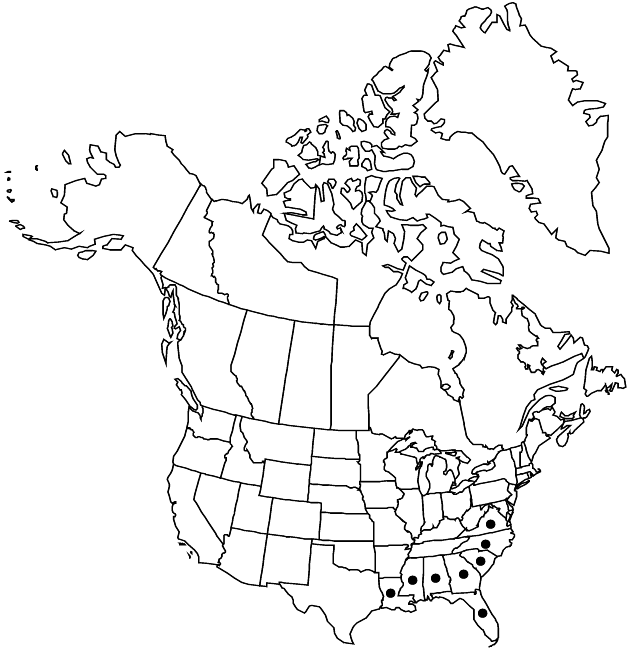Chrysopsis gossypina
Sketch Bot. S. Carolina 2: 337. 1823.
Biennials, or short-lived perennials, 20–70 cm; taprooted (propagating by basal rosettes at proximalmost nodes of old stems and at ends of rhizomes and roots). Stems 1–5 (–80 in subsp. cruiseana; from rosette), procumbent, ascending, or erect (sometimes purple-tinged), simple or branched, glabrous or densely woolly, proximally often sparsely glandular, distally sometimes densely so or eglandular. Leaves: (perennating rosettes often sparsely woolly); basal sessile, blades oblanceolate, 3–10 × 1–3 cm, margins sometimes apically dentate, faces sparsely to densely long-woolly; cauline leaves spreading to ascending, blades linear to linear-lanceolate, oblanceolate, oblong, or ovate-elliptic, reduced distally, margins entire, piloso-ciliate, apices obtuse to acute, sometimes mucronate, faces sparsely to densely woolly, sometimes glabrescent. Heads 1–30 in compact to lax subumbelliform to corymbiform arrays. Peduncles 1–6 cm, glabrous, woolly, or sparsely to densely stipitate-glandular; bracts and bracteoles oblong to lanceolate or linear (margins often ciliate), glabrous or woolly, eglandular or sparsely to densely stipitate-glandular. Involucres campanulate to hemispheric, 8–13 mm. Phyllaries in 4–5 series, linear to linear-oblanceolate, 0.6–1.1 mm wide, strongly to weakly unequal, apices usually appressed, sometimes spreading or recurved, usually acute, sometimes attenuate, faces usually glabrate, sparsely to densely woolly, or sparsely to densely stipitate-glandular, rarely eglandular. Ray-florets (9–) 16–30; laminae 7–12 × 1.5–3 mm. Disc-florets 25–70; corollas 6–7.5 mm, lobes 0.5–1 mm. Cypselae 2.5–3 mm, 0–6-ridged (ridges yellow to redbrown, translucent, clavate), shallowly ribbed, faces sparsely long-strigose; pappi in 3 series, outer of linear to linear-triangular scales 0.5–1 mm, inner of 25–35 bristles 5–8 mm, inner weakly clavate. 2n = 18.
Distribution

Ala., Fla., Ga., La., Miss., N.C., S.C., Va.
Discussion
Subspecies 3 (3 in the flora).
Chrysopsis gossypina is a highly variable species with a confusing range of variation in habit, leaf shape, indument, and phyllary traits. The very different-looking extremes that closely resemble other species appear to be the result of local adaptation and loss of one or the other ancestral parental traits from the allopolyploid genome. Three subspecies are recognized with mostly allopatric ranges. Intermediates between subspecies occur in areas where the ranges overlap in panhandle Florida.
Interspecific hybridization occurs in panhandle Florida near the coast between this species and C. godfreyi (J. C. Semple and C. C. Chinnappa 1980), and possibly also with C. linearifolia.
Selected References
None.
Lower Taxa
Key
| 1 | Perennials; stems procumbent, branched proximally, older plants with up to 80 flowering branches; mid and distal cauline leaves numerous (100+ on longer stems), crowded, linear-elliptic to oblong, margins eciliate, glabrous; heads in compact umbelliform arrays; phyllaries appressed, glabrate or glabrous, a few stipitate glands proximally on outer series; (coastal dunes and barrier islands, w panhandle Florida) | Chrysopsis gossypina subsp. cruiseana |
| 1 | Biennials or short-lived perennials; stems procumbent to erect, simple or branched; mid and distal cauline leaves 10–50+, sometimes crowded, blades linear, lanceolate, oblong, or ovate, sparsely to densely woolly at least along margins; heads in lax to compact corymbiform or subumbelliform arrays; phyllaries glabrate to densely woolly, sparsely to densely stipitate-glandular | > 2 |
| 2 | Biennials or short-lived perennials, 10–100 cm; stems 1–5+, procumbent to erect, simple or branched; mid to distal cauline leaves broadly lanceolate, oblong, or ovate, margins sparsely to densely woolly or sometimes distal cauline eciliate (forma trichophylla), faces sparsely to densely woolly, distal sometimes glabrate; heads (few) in lax corymbiform arrays; phyllaries usually sparsely to densely woolly or sparsely pilose and densely stipitate-glandular, rarely glabrous or glabrate; e panhandle and n peninsular Florida, Georgia to se Virginia on inner and outer coastal plain | Chrysopsis gossypina subsp. gossypina |
| 2 | Usually short-lived perennials to 80 cm; stems 1–5+ (older plants), ascending to erect, rarely procumbent, usually simple; mid to distal cauline leaves linear to lanceolate or linear-oblanceolate, margins coarsely long-pilose, sparsely pilose to glabrate; heads usually in subumbelliform arrays, sometimes in compound subumbelliform arrays; phyllaries glabrate, apices spreading; Louisiana to c panhandle Florida, a few scattered locations east | Chrysopsis gossypina subsp. hyssopifolia |
"thin" is not a number."[" is not declared as a valid unit of measurement for this property."]" is not declared as a valid unit of measurement for this property.